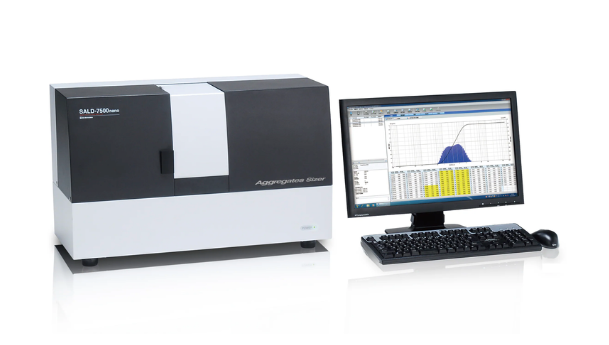
Aggregates Sizer
Measures the concentration of 100 nm to 10 µm aggregates of biopharmaceuticals
The Aggregates Sizer aggregation analysis system enables the quantitative evaluation of particle amounts in the 0.1 µm to 10 µm range as a concentration (units: µg/mL or particles/mL)*1.
Aggregations of biopharmaceuticals can be categorized*2 into 4 ranges: nanometer (<100 nm), submicrometer (100 nm to 1 µm), subvisible (1 to 100 µm), and visible (>100 µm), according to their particle size.
Until now, particles in the submicrometer to subvisible portion of this range (100 nm to 10 µm) were generally measured by combining multiple methods.
Product Description
Measures the concentration of 100 nm to 10 µm aggregates of biopharmaceuticals
The Aggregates Sizer aggregation analysis system enables the quantitative evaluation of particle amounts in the 0.1 µm to 10 µm range as a concentration (units: µg/mL or particles/mL)*1.
Aggregations of biopharmaceuticals can be categorized*2 into 4 ranges: nanometer (<100 nm), submicrometer (100 nm to 1 µm), subvisible (1 to 100 µm), and visible (>100 µm), according to their particle size.
Until now, particles in the submicrometer to subvisible portion of this range (100 nm to 10 µm) were generally measured by combining multiple methods.
Technical specifications
Violet laser allows accurate measurements of ultra-small particles
The light intensity distribution pattern varies little relative to the particle size distribution when the particle size drops to several tens of nanometers. This is the reason for the minimum limit of detection of the laser diffraction method. A violet laser creates clearer differences in the light intensity distribution pattern at ultra-small particle sizes than a red laser. Consequently, a violet laser is used to enhance the measurement performance for ultrafine particles of the order of several tens of nanometers.
Measurement is performed on particle groups
Particle size distribution measurement is not performed on individual particles, but on particle groups made up of a large number of particles. Particle groups contain particles of different sizes, and the light intensity distribution pattern emitted by a group is composed of all the scattered light emitted from all the individual particles. The particle size distribution, in other words, what particle sizes are present in what proportions, can be obtained by detecting and analyzing this light intensity distribution pattern. This is the basic principle behind the laser diffraction method.
Particle sizes from 100 nm to 10 µm can be measured with a single system
Particle concentrations (µg/mL or particles/mL) can be evaluated quantitatively using WingSALD bio, special software for the Aggregates Sizer.
High linearity of concentration

High repeatability
The stable optical system used with the laser diffraction method enables accurate detection of scattered light.
High resolution – Detect multiple peaks accurately
The intensity of scattered light from large particles is high and changes frequently within the forward small angle. In contract, the intensity of scattered light from small particles is very low and changes slowly within the large angle.